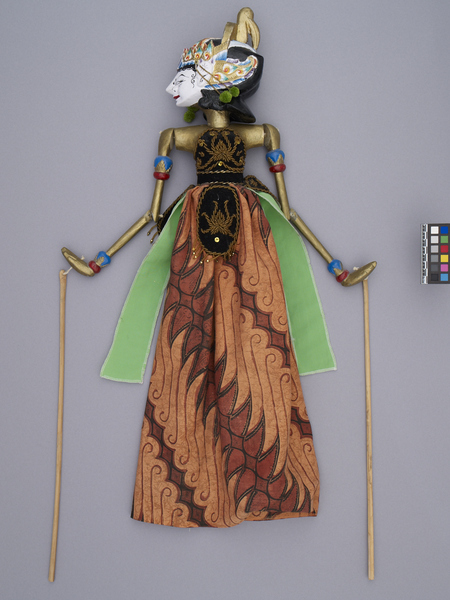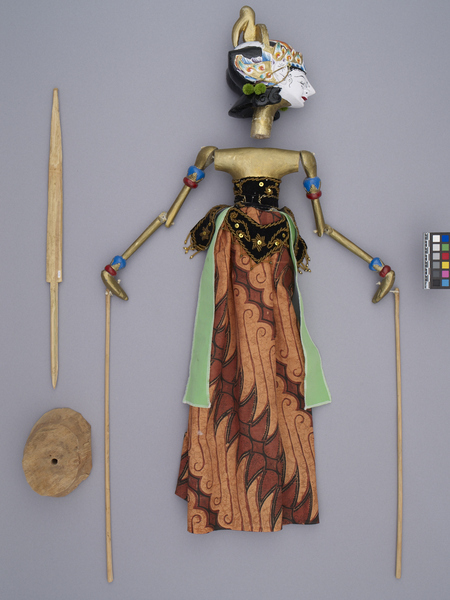Rod Puppet Item Number: 2872/26 a-d from the MOA: University of British Columbia



Description
Rod puppet called Sri Kandi, a warrior archer. The wooden head (part a) has a white face with features painted in black, and a red mouth and forehead decoration. The nose and ears protrude, and green pompoms hang down both sides of her face. Covering her black hair is a colourful diadem that includes a carved pelican. The golden torso is covered by a beaded black velvet bodice with hanging panels and wide green ribbons. A sarong hides a wooden stick (part c) that extends up through the torso and into the puppet’s head to control its movement. The arms are moveable at the elbows and shoulder by wooden sticks attached to each hand. The stand (part d) is a round piece of unpainted wood.
History Of Use
Javanese puppetry as an art form probably developed by the 11th century. Wayang golek (rod puppets) of western Java appeared during the 16th century. Originally the plays depicted Javanese mythology, but after the Indian conquest of Java the Hindu epics, Ramayana and Mahabharata, were incorporated into the cycles, which comprise about 200 plays. A dalang (puppet master) performs the plays to celebrate important occasions, usually in three acts, with vocal and instrumental accompaniment. Typically they serve a moral and religious purpose, and more recently, one of political commentary. The Mahabharata cycle of plays, involves the usurpation of the Pandawa throne by the Kurawa brothers, and their eventual defeat.
Iconographic Meaning
Represents Srikandi (Sri Kandi), warrior archer and the wife of Prince Arjuna in the Mahabharata; a semi-refined (ladak) character.
Item History
- Made in West Java, Indonesia
- Collected between 1990 and 1999
- Owned by Betty Cairney
- Owned by Jack Cairney before March 15, 2011
- Received from Jack Cairney (Donor) on March 15, 2011
What
- Name
- Rod Puppet
- Identification Number
- 2872/26 a-d
- Type of Item
- puppet
- Material
- wood, cotton fibre, plastic and paint
- Overall
- height 65.5 cm, width 17.0 cm, depth 49.0 cm
- Puppet
- height 92.0 cm, width 17.0 cm, depth 14.0 cm
Who
- Culture
- Sundanese
- Previous Owner
- Betty Cairney and Jack Cairney
- Received from
- Jack Cairney (Donor)
Where
- Holding Institution
- MOA: University of British Columbia
- Made in
- West Java, Indonesia
When
- Collection Date
- between 1990 and 1999
- Ownership Date
- before March 15, 2011
- Acquisition Date
- on March 15, 2011
Other
- Condition
- good
- Accession Number
- 2872/0026 a-d